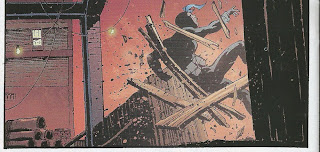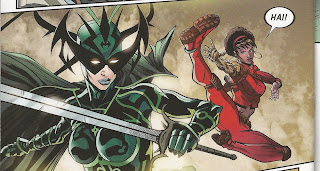Pick of the Brown Bag
March 13, 2013
by
Ray Tate
With only Batman, Batgirl, Fearless Defenders, Superboy, Wolverine and new title Sledge-Hammer, the Pick of the Brown Bag is mighty thin this week. Overall the theme is death. Specifically, the death of Robin.
What amazes me most about this theme is that no news organization ran with the story. When DC created Batwoman, every agency gave this subpar, two-dimensional cipher leeching off of Batgirl's resonance far too much publicity.
For the person on the street, the announcement meant Yvonne Craig, Barbara Gordon and/or Batgirl was gay. Laypeople didn't realize that Babs had been crippled for twenty-three years. Neither did reporters. So the death of Robin?
Got nothing.
It's almost as if the media actually did its job, investigated and said, "Say, wait a minute, this isn't the original Robin. He's still alive." More likely, newspeople were too busy falling over themselves to report on what shoes the retired fossil pontiff intended to wear. I wish that were hyperbole. Et tu, NPR?
I know the oversight wasn't due to a massive media orgasm over the confirmation of the Higg's Boson's existence by CERN. For any accuracy and depth about that item, you had to go to the Internet newsites for such a report, especially The Huffington Post.
So, spring is nearly here, and robins adorn the covers of the Batman Family titles. I know DC thought the robins were touching monuments to the dead sidekick, but I find their addition silly and overblown.
The ubiquitous presence of robins undermines the intent of the artists trying to evoke real emotion from the imagery or characters. They don't always succeed. When I saw the boots on the cover of Batman Nancy Sinatra started crooning in my head.
Slapping robins on the covers improves nothing. The contents of the books deal with Robin's death far better. For example, Huntress in last week's World's Finest felt sorrow over Robin's death. She only met the tyke once but fought beside him and connected with him as kin. His death served as a reminder that Helena lost everyone she cared about and may lose everyone she will care about.
For Batgirl, the death of Robin draws more sympathy for how Batman must feel. That makes sense. She really didn't know Robin, and her platonic love for Batman has never wavered.
Barbara's father relates the sorrowful news. Commissioner Gordon knows Barbara is Batgirl, and Gordon feels more than she because he encountered the new Robin often. Robin's death further reminds him that he has a daughter that lays her life on the line as Batgirl.
The Commissioner learns of Robin's death from Batman himself. This represents another astounding change from the close-mouthed vigilante of old. In the post Crisis, Batman did not reveal that Jason Todd had died. Again, the new 52 exhibits a far healthier attitude toward its heroes, even when they face death.
Batman receives help in dealing with Robin's death from Scott Snyder's Lisbeth Salander stand-in Harper. The entire tale in Batman deals with Harper's and Batman's relationship. Harper and her brother Cullen were orphaned by crime. Their father rots in Blackgate prison.
Their mother died. Harper's a tough character. She defends her brother against prejudice, and she sees Batman as Gotham City's only hope. To that extent, she confronts him over his recent, destructive behavior.
Batman has told Harper to stay out of his life, for he fears she will die if she gets too close. Many readers believe that she will take the place of Robin, but I disagree. Snyder has set her up to be a recurring character but not Robin. She's too devoted to her brother, and her electronics genius doesn't extend to martial arts.
Robins must somehow lose everything before finding themselves under Batman's care. Dick's and Jason's parents were slain. Tim Drake's parents enter witness protection. Harper and Cullen haven't lost everything. They have each other.
By the end of the story, Batman finds himself apologizing to Harper--an apology from Batman!--and more accepting of her being in his life, however tangentially.
The peripheral elements of Batman work quite well within the context of demonstrating Batman's grief and anger in one violent fist perfectly launched by Andy Kubert. Snyder finds the ideal foil for a Batman not quite up to his usual standard and just for good measure adds an element of subtle, street-level science fiction to make the threat even more formidable. That said, it's still plausible that Harper could have found a way to deal with a menace capable of defeating Batman on his worst day.
There are four plot threads in Batgirl, and guest writer Ray Fawkes deals with three of them well. First, there's clean up from the Joker fall out. Second, Batgirl must deal with an arsonist. Third, is of course Robin, and fourth and least spotlights Batgirl's psychopath brother James Jr.
Batgirl possesses a photographic memory. Babs last issue identified the Joker's men through their faces. She then notified the police. This issue, we see them in jail. It's a nice change from what Gotham frequently appears to be and exemplifies the overall good police work without undermining the Batman Family presence.
I never became involved with books like Gotham Central because apart from Commissioner Gordon, the police of Gotham City are third tier characters. They exist to enhance the story of the Batman Family. They shouldn't be interesting enough to carry their own series. A story or two, sure, but if the cops are efficient enough to stop the madmen, why do we need a Batman Family?
Batgirl's crusade against the arsonist torching her territory is an excellent tether for the more associative threads. His element is dangerous enough to put Batgirl through the wringer, amply illustrated by Daniel Sampere and Vincente Cifuentes, and provide her with enough clues to shut him down.
Simultaneously, writer Fawkes shows just how much Gotham City loves Batgirl. This is reflective of Gail Simone's premiere issue.
James Jr.'s machinations are the least interesting and successful. Rather than come off like the Hannibal Lecter the writer and editor want him to be. He instead represents a low-rent level of serial nuisance recalling the central figure in the Ed Wood quality Teenage Strangler.
"I'm going to kill you, Barbara... Just not now! Mwa-ha-ha-ha-ha-ha!"
I mean, what is the point? The young idiot respects his sister as Batgirl enough to know that she's not going to be fazed by his taunts nor unnerved by his shenanigans, which stupidly involve staking a bat to the wall of an abandoned house. I don't even think he managed to kill this poor creature. The little, loser dumbass. Either have at it and be beaten, or take your meds and get better. Is it still too late to trade him in for Barbara's brother from the pre-Crisis universe Tony Gordon, CIA spy?
Superboy impressed me during the "H'el on Earth" storyarc running through the Superman titles. After H'el denounced Superboy as a clone (Kon-El) he found himself on the crazy's dissecting table, figuratively speaking. It wasn't actually a table. Despite this, Superboy manned up. He held his body together through telekinesis and helped save planet earth by destroying H'el's star-sucking device.
In his latest issue of his title, Superboy is actually the least interesting character. Scott Lobdell's tale takes Superboy on the road to redemption. Superboy took a good hard look at corruption in H'el and didn't like what he witnessed. On this road, Superboy attempts to return the money he robbed from a bank. His good intentions lead to a conflict with the new 52 Plasmus.
 Plasmus was one of a handful of final pre-Crisis creations. A member of the new Brotherhood of Evil, Plasmus served Ze Brain and tormented the Teen Titans. His inclusion in Superboy sort of makes sense. Teen hero, traditional teen hero villain. Like everything else in the new 52, this George Perez designed character gets amped to eleven by artist R.B. Silva and the Hories.
Plasmus was one of a handful of final pre-Crisis creations. A member of the new Brotherhood of Evil, Plasmus served Ze Brain and tormented the Teen Titans. His inclusion in Superboy sort of makes sense. Teen hero, traditional teen hero villain. Like everything else in the new 52, this George Perez designed character gets amped to eleven by artist R.B. Silva and the Hories.
Lobdell then pulls a fast one. He combines two characters who have never had anything to do with each other into one. Dr. Psycho was a classic Wonder Woman foe. Kid Psycho was a noble auxiliary member of the Legion of Super Heroes who would die if he used his power too frequently. Dr. Psycho was an oft-sleazy maniac. Kid Psycho was a tragic figure. Smooshed, they're hilarious.
Ken Lashley joins Lobdell on the back up tale which calls back one of the classics of the Superman Family. This story involving a beautiful alien fugitive and Khunds packs an awesome punchline that will make you grin from ear-to-ear.
Fearless Defenders second issue quiets the title down. The only kickassery you'll find is a powerless Dani Moonstar putting Hawkeye to shame by skewering five mercenaries.
Then Valkyrie engages in a swordfight against Hela, the Asgardian Queen of the Underworld. Oh, wait. That's a lot of kickassery.
Damn right. The second issue is as awesome as the first. Cullen Bunn, artists Will Sliney and Veronica Gandini can take a well-deserved bow.
Paul Cornell and Alan Davis debut a new Wolverine series, and I've got to say it's got legs. Cornell bridges all the aspects of Wolverine that have formed his personality over the years. He attempts to keep a child hostage calm like a teacher might.
 He dispenses with the cops that happen on the scene by showing his super-hero creds. He demonstrates his mutant power as artist Davis displays an uncanny ability to evoke Wolverine's pain; something few artists attempt or even remember that Logan can experience. He heals rapidly. It still hurts.
He dispenses with the cops that happen on the scene by showing his super-hero creds. He demonstrates his mutant power as artist Davis displays an uncanny ability to evoke Wolverine's pain; something few artists attempt or even remember that Logan can experience. He heals rapidly. It still hurts.
Cornell also turns the corner of the book by showing that Wolverine cannot be swayed by the innocent appearance of a foe. He's a pragmatic dispatcher of justice, and he will do what needs to be done. All and all, an outstanding new series with a neoclassic character.
 This week also marks the debut of Mike Mignola's and John Arcudi's Sledge-Hammer. This isn't exactly a new concept.
This week also marks the debut of Mike Mignola's and John Arcudi's Sledge-Hammer. This isn't exactly a new concept. 
 Most writers attempt to make the idea of robots battling Nazis fun, but Mignola, Arcudi and artist Jason Latour blend the authenticity of the 1960s drama Combat! and Tesla's science.
Most writers attempt to make the idea of robots battling Nazis fun, but Mignola, Arcudi and artist Jason Latour blend the authenticity of the 1960s drama Combat! and Tesla's science.
This mix evolves a uniquely grim atmosphere. Mignola and Arcudi furthermore demonstrate Nazi guile and add to their arsenal to counterbalance the presence of an American robot on the battlefield. This is easily the best story I've read by the team of Arcudi and Mignola.



















You're right, no media coverage of Robin's death is pretty weird. Especially as he's had his own book for a couple of years.
ReplyDeleteLooks like Cardinals outweigh Robins :)
ReplyDelete